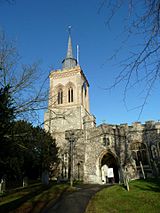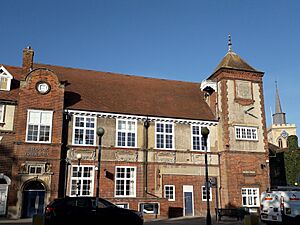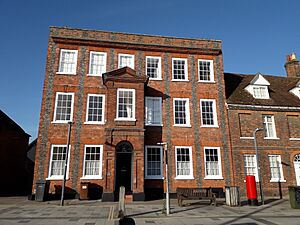Baldock facts for kids
Quick facts for kids Baldock |
|
|---|---|
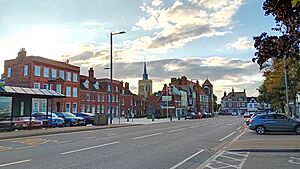 Baldock High Street |
|
| Population | 10,615 (Built up area, 2021) |
| OS grid reference | TL247337 |
| District |
|
| Shire county | |
| Region | |
| Country | England |
| Sovereign state | United Kingdom |
| Post town | BALDOCK |
| Postcode district | SG7 |
| Dialling code | 01462 |
| Police | Hertfordshire |
| Fire | Hertfordshire |
| Ambulance | East of England |
| EU Parliament | East of England |
| UK Parliament |
|
Baldock is a historic market town in Hertfordshire, England. It's about 33 miles (53 km) north of London. The River Ivel starts from springs right here in town! Baldock is close to other towns like Royston, Letchworth, Hitchin, and Stevenage.
Contents
Baldock's Ancient Past
Baldock has a very old history, with people living here for thousands of years. We know this from amazing archaeological finds.
Early Settlements
The area around Baldock has been settled since the Stone Age and Bronze Age. This means people have lived here for a very long time!
Around 100 BC, during the Iron Age, Baldock became a huge settlement called an oppidum. It might have been the biggest one in Britain! Later, it grew into a Roman town. Even though it wasn't a major city, it was an important religious place. Many ancient coins have been found here, showing how active the area was. People lived here until about the 5th or 6th century. After that, the Roman settlement slowly disappeared.
Founding by Knights Templar
Baldock was officially started in the 1140s by the Knights Templar. They were a famous group of medieval knights. They created Baldock as a market town on land given to them by Gilbert de Clare, a powerful earl. The town's secondary school, The Knights Templar School, is even named after them!
What's in a Name?
The name Baldock might come from an Old French name for Baghdad, which was called Baldac or Baudac. Baghdad was known as a very rich market city. Perhaps the Knights Templar hoped their new town in England would become just as successful! The name "Baldac" was first recorded in 1168.
Some people think the name might have come from an older English name. It could be from "balled" (meaning bald) and "oak" (like a large, old tree). Or it might be from an Old English personal name, "*Bealdoc". But the Baghdad connection is a popular story!
Medieval and Coaching Town
The town's current layout and many buildings in the center are from the 16th century. Baldock was a key stopping point between London and the north of England. This was because it was located where two important old roads crossed: the Great North Road and the Icknield Way. Many old inns, where coaches used to stop, are still pubs and hotels today. Baldock has a surprising number of pubs for its size! The main street, High Street, is very wide. This was common for medieval market places, where there used to be more rows of buildings.
Brewing History
Since the 16th century, Baldock has been famous for making malt, which is used in brewing. It became a big brewing center. Even in the late 1800s, there were at least three large breweries. In 1881, there were about 30 places to drink in Baldock! Many people from the nearby town of Letchworth used to visit Baldock for drinks, as Letchworth had very few places to buy alcohol for a long time.
Modern Transport Links
Since 1850, Baldock has had a train station. Today, you can catch a train to London Kings Cross or Cambridge. Many people who work in London live in Baldock because of the quick train service.
Archaeological Finds
Even before the modern town was founded, people lived here. Prehistoric remains from around 3000 BCE have been found. Many Roman artifacts have also been discovered, showing a Roman settlement in the town center. Some Iron Age finds suggest Baldock might be the oldest town ever to develop in Britain!
In 2003, a medieval leper colony was found on Royston Road. From 1808 to 1814, Baldock had a station for a special shutter telegraph system. This system connected the Navy in London to its ships in Great Yarmouth.
Famous Visitors
Because of its location, Baldock has hosted some famous visitors. King Charles I passed through in 1648 after his arrest. The famous highwayman Dick Turpin is also said to have stopped here. The preacher John Wesley visited the town in 1747.
Film and Industry
Baldock was once home to a film processing factory. Later, it became the Kayser Bondor ladies stocking factory, which even made parachutes during World War II. Today, this site is a Tesco supermarket, but it kept the old factory's cool Art Deco front!
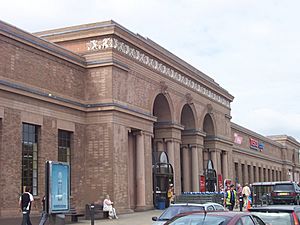
St Mary the Virgin Church
A very important building in Baldock is the Parish Church of St. Mary the Virgin. It's in the center of town and was first built around 1150 by the Knights Templar. It was mostly rebuilt around 1330 by the Knights Hospitaller. It's a Grade I listed building, meaning it's very important historically.
Today, Baldock is mostly a commuter town, meaning many people live here and travel to work in other places.
Local Football Team
The local football team, Baldock Town F.C., was first formed in 1905. The original club stopped in 2001, but a new one started up two years later.
Baldock Radio Station
Baldock Radio Station opened in 1929. It made the first successful radio call to the USA that year! During World War II, it helped the Allies by intercepting German Navy signals and sending them to Bletchley Park to be decoded.
Getting Around Baldock
Baldock is at the crossing of two old, important roads: the Great North Road and the Icknield Way.
Bypasses
In 1963, the A1(M) motorway was built, and it was called the Baldock Bypass for a while. This helped traffic flow better, as Baldock used to be a big bottleneck on the main north-south route. In 2006, a new bypass was built for the A505 road, which also helped remove traffic from the town.
Fun Events in Baldock
Baldock hosts several exciting events throughout the year.
Baldock Festival
The Baldock Festival started in 1982. It's a cultural festival that lasts for three weeks, starting on the May Day bank holiday weekend. There are many activities like museum displays, wine and whiskey tasting, brewery tours, comedy shows, and music events. The Street Fair is a highlight, held on High Street, where stallholders often dress up in themed costumes!
The Baldock Beer Festival is part of the main festival. It's held on the first weekend, and you can try many different local and national beers and ciders.
Baldock Charter Fair
Baldock's Charter Fair is very old, dating back to 1199! King John gave the Knights Templar the right to hold a yearly fair. Today, the main part of the fair is a fun amusement fair that sets up rides in the High Street. It usually takes place on October 2nd, 3rd, and 4th.
Balstock Music Festival
Balstock is Hertfordshire's biggest free music festival! It started small but has grown into a three-day event with over 200 artists playing on many stages across the town. All the money raised goes to a chosen charity.
Baldock in Books
Baldock has been mentioned in several books:
- Daniel Defoe wrote about "Baldock Lane" in his book A tour through the whole island of Great Britain. He said it was so bad that travelers had to make their own paths!
- The town is mentioned in Ruined City by Nevil Shute.
- It's frequently mentioned in the supernatural thriller The Green Man by Kingsley Amis.
- Author Monica Dickens wrote about her visits to Baldock and The George and Dragon public house in her 1978 book An Open Book.
How Baldock is Governed
Baldock has two levels of local government: the North Hertfordshire District Council and the Hertfordshire County Council. Baldock doesn't have its own town council. Instead, local matters are discussed by the North Hertfordshire District Council's Baldock and District Committee.
Past Local Government
For a long time, Baldock was governed like a rural area. In 1872, the town decided to create its own local board to manage public health and other town services. This board later became the Baldock Urban District Council in 1894.
The council built the Baldock Town Hall in 1897. It had a public hall, council offices, a fire station, and a library. Later, in 1936, the council moved its main offices to a larger house called The Grange.
In 1974, the Baldock Urban District was changed and became part of the larger North Hertfordshire district.
Schools in Baldock
Baldock has several schools for different age groups.
Primary Schools
- St Mary's Church of England (VC) Infant School
- St Mary's Church of England (VC) Junior School
- Hartsfield Junior Mixed and Infant School
- St John Roman Catholic Primary School
Secondary Schools
- The Knights Templar School
- Brandles School
Famous People from Baldock
Many interesting people have connections to Baldock:
- Arthur Archdale (1882–1948), a cricketer and army officer.
- Robert Bennet (died 1617), an Anglican bishop.
- Sir Peter Bonfield (born 1944), a business leader.
- Lizzie Hall (born 1985), an athlete who studied here.
- Reginald Hine (1883–1949), a local historian.
- Albert Ireton (1879–1947), an Olympic tug of war competitor and boxer.
- Keith Milow (born 1945), an artist who grew up here.
- Ben Mosley (born 1981), an expressionist artist.
- David Rhodes (born 1988), a singer and songwriter.
- Rev. John Smith (1799–1870), a local rector who was the first person to read the famous Diary of Samuel Pepys.
- Tom Smith (born 2002), a football goalkeeper.
- Deborah Turness (born 1967), a top news executive at BBC News.
- Elizabeth Walker (1583-1673), a passenger on the Mayflower ship. Her descendants include many famous Americans!
- Leanne Wilson (born 1980), an actress.
Media and News
Local news for Baldock is provided by BBC East and ITV Anglia. You can listen to local radio stations like BBC Three Counties Radio and Heart Hertfordshire. The local newspapers are The Comet and Hertfordshire Mercury.
Sports and Fun
Baldock has a small museum next to the Arts and Heritage Centre in the Town Hall.
Clubs and Teams
- Baldock has a Cricket Club with three teams.
- There's also a Netball Club and a Bowls club, all located in Avenue Park.
- The town has a Non-League football club called Baldock Town F.C..
- There's also a Sunday league football team called Templars FC.
Walking Trails
The 110-mile Icknield Way Path, a long walking trail, passes right through Baldock.
Nearby Villages
- Ashwell
- Bygrave
- Caldecote
- Clothall
- Hinxworth
- Newnham
- Radwell
- Wallington
- Weston
Images for kids
See also
 In Spanish: Baldock para niños
In Spanish: Baldock para niños



